Use [CONTR + F] to search this page and pull down this scroll bar to see everything.
|
Years of Issue:
|
A number of these stamps was ordered at the Dutch postal services (TNTpost - PostNL) by private persons. I don't know the number of stamps in a series or the exact date of isssue of these stamps which were ordered by private persons. |
|
several years (exact year of issue unknown) |
|
Philamaxx is a webshop for Philately & Postal history. It started as a stamp shop in 1936. PhilamaxX has built up a good reputation in the sales and development of Personal Stamps (PPZ) with trains. Some of their personal stamps are shown here. railway wagon 3 Hoefijzers Bier + accident crane NS 1200 + loco line-up "koploper" + 1960's seal
No entry in official catalogue. |
 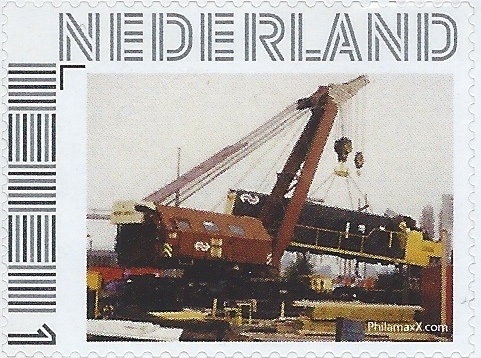 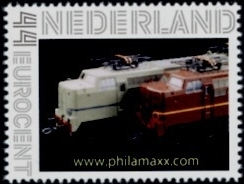 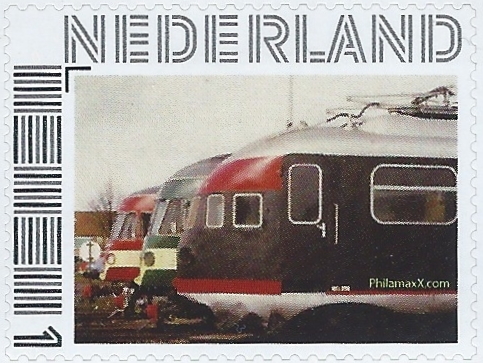   |
|
Within NS, the Service, Maintenance and Modernization departments are responsible for the maintenance of the trains. Previously this was NedTrain. They took care of technical maintenance and quick service and of cleaning and short- and long-term overhaul. NS Maintenance & Service is the Dutch maintenance company for railway equipment. The company was created after the division of the Dutch Railways, when the Equipment & Workshops department within the NS Group was privatized as NS Equipment. In 1999 the name was changed to NedTrain. In 2017, the management of NS and NedTrain decided to add NedTrain again under the NS. The stamps shown here show trains at the location Zwolle. source: Wikipedia
No entry in official catalogue. |
    |
|
set of four Dutch trains: SLT Sprinter + NS mDDM NS VIRM + NS SGMm Sprinter
No entry in official catalogue. |

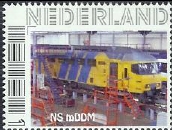 
 |
|
The Noord-Brabantsch-Duitsche Spoorweg-Maatschappij (NBDS) was a railway company which provided rail transport between Boxtel in the Netherlands and Wesel in Germany via Uden, Veghel, Gennep, Goch and Xanten. This railway line was known in the Netherlands as "Duits Lijntje" (the German Line). On July 15, 1873, the route from Boxtel to Goch was opened. On July 1, 1878, the second part of the line, the section from Goch to Wesel, was opened. The total length of the line was 92.7 kilometers, of which 52.7 kilometers were on Dutch territory. From Büderich, another 8.2 kilometers of the Köln-Mindener Eisenbahn (railway) was used, part of the line from Venlo via Wesel to Haltern, Münster and Hamburg. These two locomotives are shown: NBDS 32 (Blue Brabanter) + NBDS 36
No entry in official catalogue. |

 |
|
The following museums are shown: Diesel 3 and MAT 64 + NS 3737 in the Railway Museum in Utrecht. trains at museum Haaksbergen + a steam loco from museum line Goes Borsele.
No entry in official catalogue. |

 

|
|
The following bridges are shown: Railway bridge at Akkrum by Akkrum.net + Bridge in Zeeland by ProRail Erasmus Bridge in Rotterdam (tram traffic)
No entry in official catalogue. |
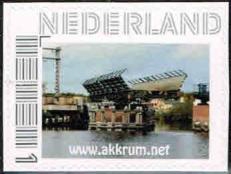
 
|
|
Wadloper (mudflats runner) in Harlingen NS 1010 on a poster + Plan U train
No entry in official catalogue. |
 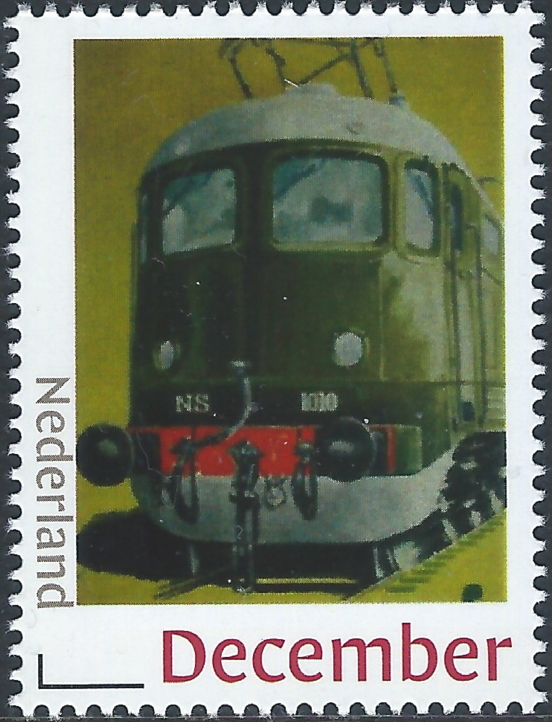
 |
|
A broken down Fyra + mat '24 steam loco 107 + NS 1200 signal box + NS 2400
No entry in official catalogue. |

 
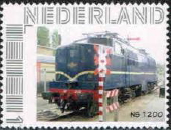 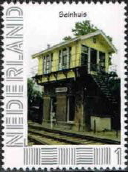
 |
|
ICM Randstadrail + ICM Martinair
No entry in official catalogue. |

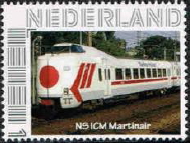
|
|
Three stamps showing the transformation of a DD-AR into a DDZ.
No entry in official catalogue. |
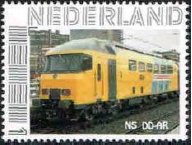
 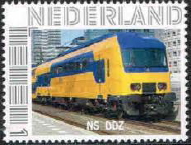
|
|
These four stamps show rail vehicles being transported by road or waterway.
No entry in official catalogue. |

 
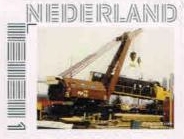 |
|
Commercial stamps from Coca-Cola.
No entry in official catalogue. |


|
|
Historic tram in Leiden with an advertisement for the Leiden newspaper.
No entry in official catalogue. |

|
|
2003 |
|
Two stamps of 0,39 euros showing two locos. One is the so-called Camel and the other is an e-loco from the 1200 series. Designer: Herman van Bostelen print: offset, Joh. Enschedé paper: non-phosphorescent with L-shaped phosphorescent beam Glue: self-adhesive Watermark: no Value: 39 eurocents Perforation: punched waveline
No entry in official catalogue. |
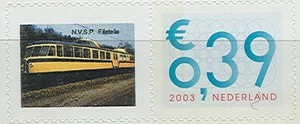  |
|
A stamps of 0,39 euros showing an RTM tram in Ouddorp. RTM stands for Rotterdamsche Tramweg Maatschappij, the Rotterdam Tramway Company. Immediately after the discontinuation of the RTM tram services in 1966, a surprising amount of equipment was saved from the demolition hammer with the help of enthusiastic private individuals. A unique museum was created: the long distance tram company of the RTM. Designer: Herman van Bostelen print: offset, Joh. Enschedé paper: non-phosphorescent with L-shaped phosphorescent beam Glue: self-adhesive Watermark: no Value: 39 eurocents Perforation: punched waveline
No entry in official catalogue. |
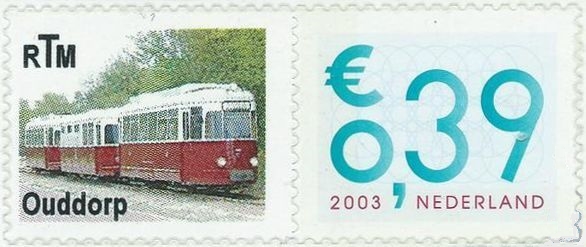 |
|
2004 |
|
2005 |
|
2006 |
|
A 0,39 euros stamp showing one of the blue trams of the NZH (Noord-Zuid-Hollandsche Stoomtramweg-Maatschappij) Designer: Studio Dumbar print: offset, Joh. Enschedé paper: non-phosphorescent with phosphorescent beam Glue: self-adhesive Watermark: no Value: 39 eurocents Perforation: 13:13¼
No entry in official catalogue. |
 |
|
2007 |
|
Two stamps of 0,44 euros showing two Märklin model locos. Designer: Hans van Halem print: gravure, Joh. Enschedé Glue: self-adhesive Watermark: no Value: 44 eurocents Perforation: punched waveline
No entry in official catalogue. |
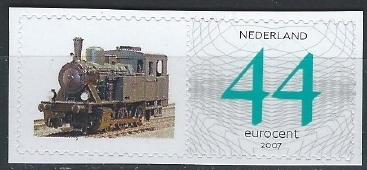 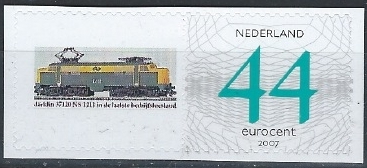 |
|
A 0,44 euros stamp with old and new trains.
No entry in official catalogue. |
 |
|
2008 |
|
Three stamps of 0,44 euros showing Randstadrail trams, operating in the Rotterdam-The Hague area.. Designer: Max Kisman print: Joh. Enschedé Glue: Watermark: no Value: 44 eurocents Perforation: various
No entry in official catalogue. |

  |
|
The National Railway Museum at the old Maliebaan station in Utrecht is promoted by these two stamps. Designer: Max Kisman print: Joh. Enschedé Glue: Watermark: no Value: 44 eurocents Perforation: various
No entry in official catalogue. |
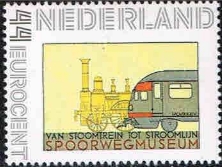
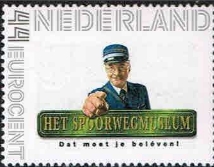 |
|
In 2008 it was a hundred years ago that the first electric tram of the ZHESM came into service between Rotterdam Hofplein and Scheveningen.
No entry in official catalogue. |
 |
|
Märklin model of an NS 1200 series loco.
No entry in official catalogue. |
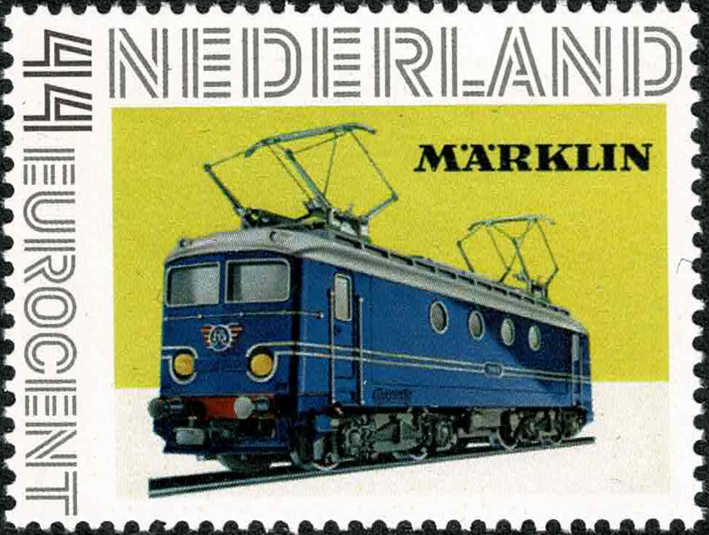 |
|
A set of four stamps with Philotrain model locomotives. The first shows NS 3737, the second NS P 4045 mailcarriage 3-axle. Number three is NS P 6021 mail carriage 4-axle and the fourth shows NS Plan-D mail carriage. Philotrain is a manufacturer of handcrafted brass railway models in Apeldoorn, the Netherlands. They manufacture rail and tramway models in scales 0 (1 / 43.5) and H0 (1/87) after Dutch and European examples.
No entry in official catalogue. |
  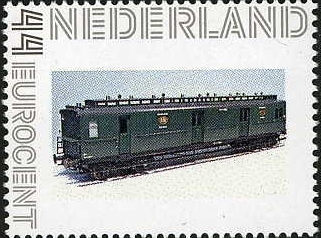  |
|
2008-2010 |
|
Blue tram of the Haarlem Transport Museum.
No entry in official catalogue. |

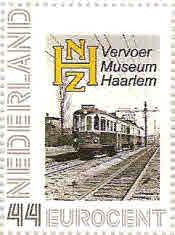 
 |
|
2009 |
|
Two stamps of 0,44 euros showing a sprinter train and Thalys HST. The third and fourth show mail trains, an old one on the left and a new one on the right. The Dutch postal service issued information leaflets on the mail trains in Dutch. They open in a new tab or window. They are here (mail trains of the sixties) and here (mail train of 1976) and here (mail train of 1989).
No entry in official catalogue. |

 

|
|
2010 |
|
This stamp of 0,44 euros shows the so-called Moerputten bridge. Moerputten is an area of natural beauty between 's-Hertogenbosch and Waalwijk. It consists of marshland (Dutch "moer", English "moor"), which made it difficult to create a railway line through it. Still the "halvezolenlijn", as it is called, was built as a line for the transportation of goods between 1886 and 1890. In 1950 the passenger service stopped to exist and in 1972 it was closed down all together. Moerputten bridge is still there and may become part of a walkway in the future. De halvezolenlijn (English: half soles line) was called thus, because it connected several places with a flourishing shoe industry. It ran from Lage Zwaluwe to 's-Hertogenbosch. The area it ran through was also called "Langstraat", as the villages and small towns originated as a long row of buildings alongside only a few streets.
No entry in official catalogue. |
 
|
|
Stamp issued on the occasion of the 8o years existence of the association.
No entry in official catalogue. |
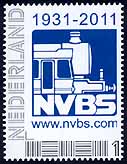 |
|
Horsedrawn tram at Damrak in Amsterdam.
No entry in official catalogue. |
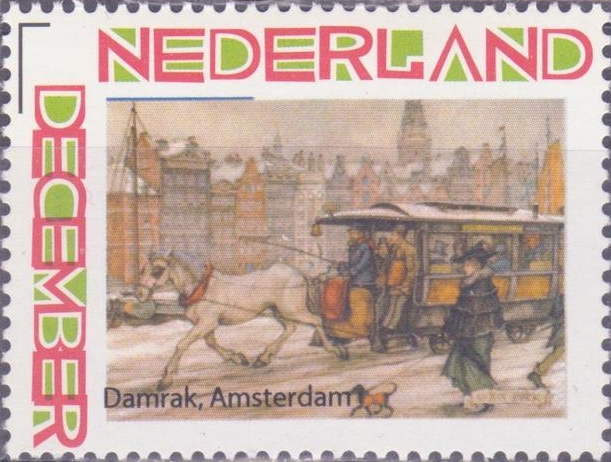 |
|
Orange tram on the occasion of the world cup competiton football in South Africa. It shows the line: We are proud of Orange.
No entry in official catalogue. |
 |
|
Several personalised tram and metro cars. This particular border was used from 2010 onward. From top to bottom : Utrecht tram + Amsterdam summer tram Rotterdam metro + Abellio NS RET tram (Rotterdam) + Utrecht tram Abellio is a subsidiary of NS for acquiring and profitably operating public transport concessions in the liberalized European market. Abellio provides bus and rail transport in Great Britain and rail transport in Germany and transports 1 million train and / or bus passengers every day. In Great Britain, Abellio implements the rail concessions for urban regional rail transport in and around Liverpool (Merseyrail) and for the rail transport in Scotland (ScotRail), West Midlands and Greater Anglia. Abellio also provides bus transport in London. In Germany, Abellio provides rail transport in the provinces of Hesse, North Rhine-Westphalia, Saxony, Lower Saxony and from mid-2019 also in Baden-Württemberg.
No entry in official catalogue. |

 
 

|
|
The association of friends of the Dutch railway museum issued a sheet of ten stamps in 2010 showing a motor mail train (mP).
No entry in official catalogue. |

|
|
The Ferphilex stamp exhibition was held in Utrecht in 2010.
No entry in official catalogue. |
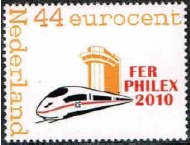
|
|
The following trams are shown: the first Rotterdam tram + RET 708 Rotterdam metro + Rotterdam tram Rotterdam tram + RET tram RET series 206 + modern tram The tram network in and around Rotterdam has nine lines that run daily and two that run on special occasions. The tram network is operated by the Rotterdam Electric Tram (RET). The track gauge is 1435 millimeters (standard gauge), the catenary voltage is 600 volts and the tram network is suitable for one-way trams. The RET has had two tramway companies in Rotterdam as its predecessor, the RTM and the RETM respectively. The RTM (Rotterdamsche Tramweg Maatschappij) was founded in 1878. The first horse tram in Rotterdam ran in 1879. The RTM ran until 1904 with horse trams and steam trams in and around the not yet so extensive city. In addition to the RTM, there were two smaller tram companies in and around Rotterdam. In 1882, the Schielandsche Tramweg-Maatschappij opened a horse tram line with 1067 mm gauge from Hofplein via Schiekade and Bergweg to Hillegersberg. The Schiedamsche Tramweg-Maatschappij opened a horse tram line in Schiedam in 1902 from the station via the Koemarkt to the Hoofdplein. This tram line had a gauge of 1000 mm. A new form of urban transport, the electric tram, came with the foundation of the new RETM (Rotterdamsche Electric Tramweg Maatschappij) in 1904. On September 18, 1905, the RETM started using the first electric tram line, line 1 Honingerdijk - Beurs - Park. Electricity was temporarily supplied by an emergency power station. On October 15, 1906, the municipality began supplying electricity from the new power station and the concession began to run for 21 years. The same year, five lines were added. In 1907 and 1908 more lines were added and the total came to nine lines. The maximum was reached in 1930 when the Rotterdam tram had 25 lines. The coaches were dark blue in the beginning, later cream and from the 1930s on yellow ocher. Since March 27, 1907, the horse tram to Overschie was the only remaining non-electric line of the RETM. The horse trams to Hillegersberg and Schiedam also continued to run. These were not part of the RETM network. The horse tram in Schiedam was discontinued on December 31, 1917 without replacement. The line to Hillegersberg became the property of the RETM in 1919. This converted the line in the years 1922 and 1923 to an electric tramline on standard gauge. On the line to Overschie the horse trams were gradually replaced in the years 1924 and 1925 by trams with petrol engines. In 1928 this line was replaced by a bus line. Since 1904, the RTM has exclusively provided transport from Rotterdam South to and from the South Holland and Zeeland islands with steam and diesel trams as well as an extensive fleet of ferries. After several years of negotiations, the RETM has transferred the tram company to the municipality. The Council decision fell on April 4, 1927 and on October 15 of that year, RETM became a municipal transport company and was named RET (Rotterdam Electric Tram). The 1,903 employees are employed by the municipality. In 1905 the first electric trams arrived in Rotterdam, the series 1-20. These motorcars with two slightly curved windows at the top and dark blue painted car bodies with brown side panels and many Art Nouveau motifs, were built by the Belgian firm Metallurgique from Hainaut. They are very similar to the first electric trams in The Hague (also series 1-20). The balconies are open so that the driver is exposed to all good and bad weather. 12 cars had long benches with a total of 20 seats and the other cross benches with a total of 19 seats. In 1912 these trams were painted cream and had closed balconies. In 1922 the 2 curved side windows were replaced by 6 small windows. These trams went out of service in 1931. Motor cars 1 and 11 have been preserved for posterity as museum trams and are ready to drive. The series consisted of two parts, 1-12 and 13-20. Car 11, which is still present, has cross benches, but it was originally car 17. Contrary to what was normal with the RET, that the box number determined the carriage number, for car 11 the truck number determined the carriage number. As in The Hague, the next series of trams for Rotterdam is large due to the enormous expansion of the tram network (see map). The trams from the series 21-126 have three side windows and long benches, in this case with a total of 18 seats. The "" series 21-70 "" was delivered by the Belgian company Ragheno in 1906. Another Belgian company delivered the "" series 71-90 "" the same year and the Metallurgique company also delivered the "" series 91-106 in 1906. "". In 1907 Allan from Rotterdam delivers the "" series 107-126 "". All these trams are delivered in dark blue colour but they are later painted cream. From the start, these trams already have a screened-off balcony. All these trams went out of service in the years 1931 to 1934. In 1908 the tram manufacturer Allan from Rotterdam built a follow-up series: 127-151. These too were first dark blue and later cream. This series was modernized by the RET in 1931 and 1932. They then got the new RET colours black and yellow ocher. In the years between 1938 and 1941 most of them were converted into trailers. The last ones went out of service in 1950. The motor cars 86 and 119 have been preserved as museum trams and are ready to drive. It is worth noting that car 119 also ran in yellow ocher with black. Series 152-176 entered service in 1913. These were trams with 4 side windows with two small ventilation windows above each window. They had 18 seats on cross benches. Due to material shortages caused by the First World War, the "" series 177-201 "" was not delivered until 1921. It concerned two sub-series that differed from each other by a slight difference in length and a greater distance between the two axes. They got their nickname 'Park wagons' because they first came into service on the then neat line 1 to the Park. In 1930 the cars were rebuilt and got the well-known black and ocher yellow equipment, doors and a pantograph as pantograph instead of a tow bar. In the Second World War, 7 cars were changed to trailers and received a 1 for the car number. In 1946 14 power cars were sold to HTM. The other trams went out of service around 1950. As a museum tram, the 192 has been preserved and restored in good condition (ex-sand motor car 2403). In 1924 the Delmez series was delivered, numbered 202-221 and built by Allan. In appearance they resemble the Hague series 800 with their 3 large and 2 three-quarter side windows. They were delivered with two single-axle bogies but during the renovation in the 1930s they got a fixed two-axle undercarriage. They were therefore the tallest two-axle vehicles that have served with the RET. Most trams in this series were taken out of service in 1956 and 1957. The 210 and 220 motor cars have been preserved as museum trams, only the 220 is operational. Between 1929 and 1931, the Rotterdam Electric Tram purchased a total of 170 four-axle electric motor cars. With the extension of line 5 to Schiebroek on January 25, 1969, their regular services came to an end; they continued to serve as rush-hour trams into the early 1970's. A few dozen wagons were used for a long time - the last until 2007 - as work wagons, some have been preserved as museum trams. The RET, which succeeded the RETM, received in its new director Dr. Ing. J.G.J.C. Nieuwenhuis a very progressive man. He modernized the Rotterdam tram with a large series of four-axle trams on two bogies. In 1929, the series 401-450, 12-meter trams, painted in black and yellow ocher, arrived with a large central balcony that accelerated entry and exit. Allan in Rotterdam, Talbot in (Aachen) and Werkspoor in Utrecht built and delivered the trams. Twenty trailers (1001-1020) were delivered by Allan and Beijnes in Haarlem. These were converted into series 451-470 motor cars in 1931. Another large order followed in 1931, the series 471-570, with more powerful engines, so that the RET now had 170 almost identical power cars that could be used on all lines. The 551-570 were built by Beijnes in Haarlem. The series 1001-1020 trailers (second series, built in 1931) were carried on heavily occupied lines 2 and 3. These trams were among the most modern in pre-war Europe. From 1943 a small series of motor cars followed, as one-way cars, the class 301-304, partly equipped with spare motors and partly with the strong engines of the 471-474 because these trams almost always ran with trailers. Two power cars destroyed by fire in 1943 were rebuilt in 1946 as one-way cars, identical to the 301-304, these became the 305 and 306. Four power cars did not survive the Second World War. Until the mid-1960s - in 1965 the weaker four-axle wagons 401-474 and the trailers had already been removed - these trams formed the backbone of the Rotterdam tram company. Many cars have been given a museum destination, including the Electric Museum Tram Line Amsterdam and the Open Air Museum in Arnhem. The 507 resides in Amsterdam, the 520, 535 and 536 reside in Arnhem. After the liberation, the RET purchased two prototypes of a more modern type of four-axle vehicles in 1948, the motor cars 571-572, renumbered 100-101 in 1950. They continued on the pre-war success of the four-axle vehicles. The series 102-135 followed in 1950-1951. This tram type built by Allan was already outdated because for years there had been experiments with other tram types, including trams (four-axle and articulated) with passenger circulation. Only the use of aluminum in the car bodies in this series can be seen as modern. The series had matching trailers, the series 1021-1056 delivered between 1948 and 1951, which formed a beautiful ensemble with 100-135. They were taken out of service between 1968 and 1983. The motor cars 109, 115, 123 and 130 have been preserved as museum trams, only the 123 and 130 are operational. Three of the trailers have been preserved: the 1040, 1042 and 1050. The 1042 is operational as a trailer with the 123, the 1050 is operational at the Tramline Nederlands Openluchtmuseum in Arnhem. In the 1950s the RET was looking for replacement trams to dispose of the last two-axle cars. These became the series 1-15 (1956; four-axle) and 231-244 (1957; six-axle). These two series were built by Wagonfabrik Schindler A.G. in Pratteln, (Switzerland). At the RET they had seen similar lightweight trams in Basel that made a big impression. They also wanted to introduce passenger circulation - get in at the back, pass a seated conductor and get out in front or in the middle. The cars were also the first with a lowered entrance. While for the classic four-axle vehicles two big steps were needed to get in, with the Schindlers passengers could suffice with one small step. Due to the multiple doors, passengers could no longer hinder each other when getting in and out, which accelerated the service. Unfortunately they were notable for their restless gait; they fluctuated. These trams were disposed of between 1982 and 1985. Two have been preserved for the museum, the 15 and 242. After the Schindlers, the Düsseldorf tram factory Düwag became the main supplier to the RET. The series 351-386 was the first bi-articulated series according to this already proven recipe. They were delivered in 1964. The series 251-274 was delivered in 1965 as a single-articulated variant. In 1975 this series was rebuilt into bi-articulated trams and renumbered 301-324. The single-articulated coaches of the series 601-635 built by Werkspoor from a few years later (1969) were almost all rebuilt in the eighties into bi-articulated cars; they received a "1" for their number and thus formed the series 1600. Many of the trams from the series 251-274, 351-386 and 600/1600 are still extensively rebuilt and repainted. Most were disposed of in the 1980s and 1990s; in 2003 they were last employed by the RET. A few trams of the 1600 series ended up in Romania after disposal. The 385, 608 and 1624 trams have been preserved in Rotterdam as museum trams. The 631 is located at the Dutch Open Air Museum tram line in Arnhem. 319 (ex-269) is located on the NDSM site in Amsterdam-Noord. In the 1980s, 100 new articulated trams in public transport yellow were delivered. These trams were numbered in the 700 and 800 series and replaced the old articulated trams from the 1950s and 1960s. These series were of a new concept, the type developed for the RET Floating Articulated Tram Car (ZGT). The 701-750 series has been completely rebuilt, while the 801-850 series uses the traction and control system of the 301-324 and 351-386 series. In the nineties, the Rotterdam colours green and white were introduced as the house colour (later replaced by green and silver). The last trams of the 800 series were taken out of service in June 2012. Some of the 800 series coaches have been sold to Gala?i in Romania. Almost all 700s were still in service until 2012. Of the 700's, the last copies were decommissioned and disposed of in 2015. The 717, 741 and 749 and the 819, 834 and 840 are now part of the collection of the RoMeO Foundation as a museum tram. As part of the HOV concept "TramPlus", the RET has purchased 60 Citadis 302 trams (5-piece) for 100 million euros. The Rotterdam version of the Citadis has a 100% low floor, is 2.40 meters wide and offers a seat for 63 passengers. At 31.5 meters, these were the longest trams in the Netherlands on delivery. On August 25, 2003, the Citadis was officially presented to the public. Since then, these trams have been used on tram line 20, later they were also used on lines 21, 23, 25 and 2. In 2007, the Citadis 2 was ordered, which are slightly shorter than the Citadis 302 coaches and are therefore suitable for the lines that have not (fully) been brought up to TramPlus level: lines 4, 7 and 8. These trams started to run in 2011 and are numbered in the 2100 series. The entire series was delivered in spring 2012; the RET now had 113 copies of the Citadis. In the meantime, one copy with collision damage has been disposed of. [source: wikipedia]
No entry in official catalogue. |
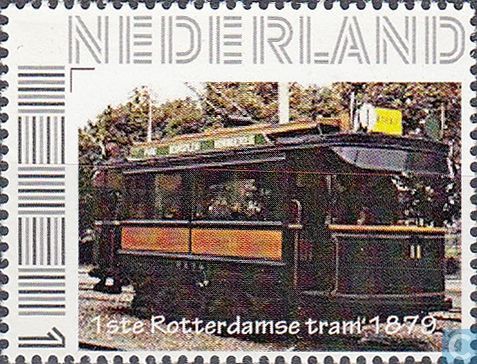
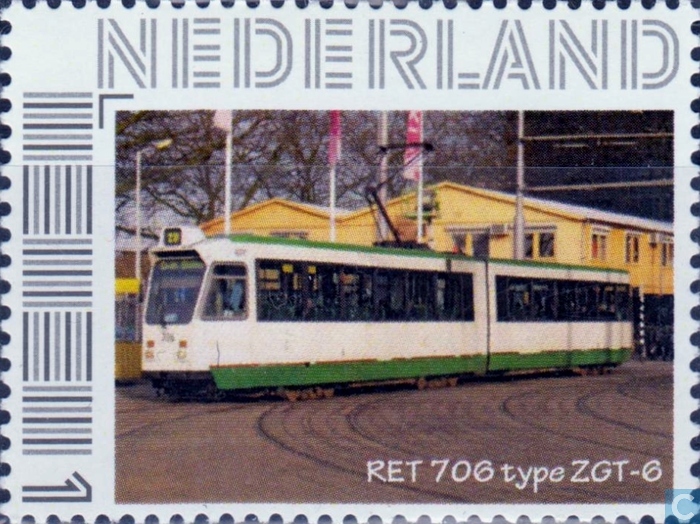 
 
 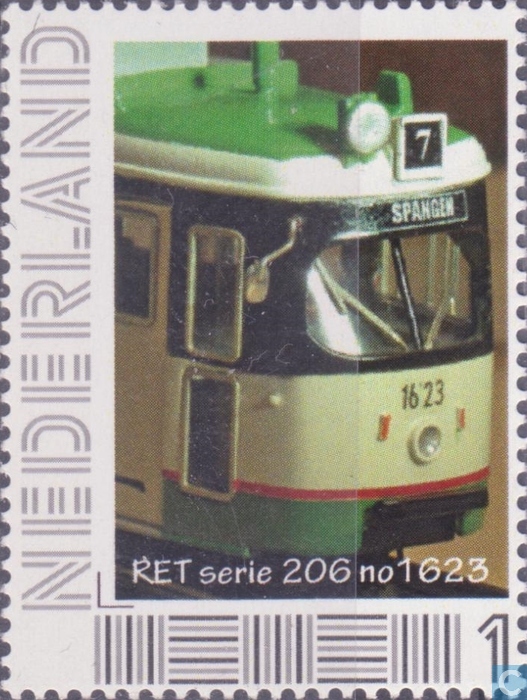
 |
|
Train at Hanzelijn: The Hanzelijn is a fifty kilometer long railway between the Dutch towns of Lelystad and Zwolle. The railway runs through the provinces of Flevoland, Gelderland and Overijssel and has two newly built stations between the stations Lelystad Centrum and Zwolle, namely Dronten and Kampen Zuid. The name of the line is taken from the Hanseatic League, the medieval federation of trading cities of which Zwolle and Kampen were part. The Hanzelijn, completed in 2012, can be regarded as an extension of the Flevolijn, completed in 1988, which runs from Weesp station via Almere to Lelystad. The operation of both lines forms a single entity and is in the hands of the NS. The owner and manager of the stations and the railway is ProRail.
No entry in official catalogue. |

|
|
Workhorse issued by...??
No entry in official catalogue. |
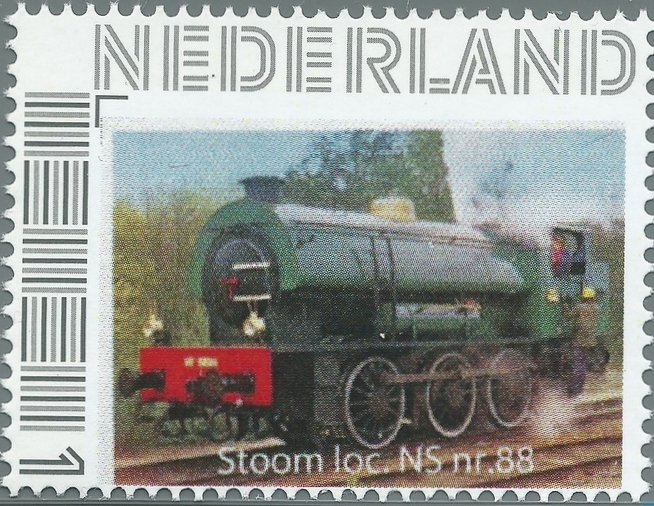
|
|
Donald Duck's nephews, Huey, Dewey and Louie, playing with a train set.
NVPH 2562-Ab-5 |

|
|
Many trams in Amsterdam are decorated, sometimes commercially, sometimes sheer decoration.
No entry in official catalogue. |
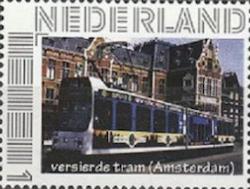
 
|
|
2010-2011 |
|
The Narrow Gauge Railway centre is a museum in Erica in the province of Drenthe. Their website http://www.smalspoorcentrum.nl is promoted on the stamps. These three stamps show: Loco 73, a diesel loco from Spoorijzer in Delft, built in 1960. Type RT11 with a Farymann Diesel 1500 rpm. Loco 59, a diesel loco from Motor Rail Bedford (Simplex), built in 1958. Type 30HP with a 35 Hp Motor Dorman 2LB. Loco 55, a diesel loco from Moës Diesel, Waremme, Belgium. probably loco4, a diesel from Motorenfabrik DEUTZ AG, type OME 117F. built in 1939. museum entrance
No entry in official catalogue. |

 
  |
|
Two stamps: one with Soest station and one with Venlo station.
No entry in official catalogue. |
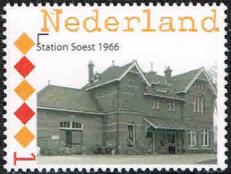
 |
|
2011 |
|
The following trains were built with Lego: NS 1200 series + NS Headrunner (Dutch: koploper) NS 1600 series + NS Sprinter NS 2200 series + NS 1100 series NS 300 SIK + NS 6400 series NS mat 64 + NS steam loco 6100
No entry in official catalogue. |
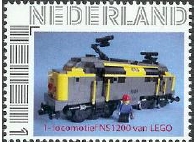
 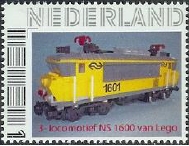
 
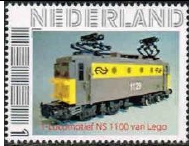 
 
 |
|
No entry in official catalogue. |

 |
|
No entry in official catalogue. |

|
|
2012 |
|
2013 |
|
Electric loco 1254 with NVBS advertising. NVBS = Nederlandse Vereniging van Belangstellenden in het Spoor- en tramwegwezen. (Dutch society of persons interested in Railways and Tramways).
No entry in official catalogue. |
 |
|
With this stamp the 's-Hertogenbosch model railway association commemorates its 35th year of existence.
No entry in official catalogue. |

|
|
Set of five NS work trains.
No entry in official catalogue. |
    
|
|
2014 |
|
Three stamps issued on the occasion of the 65th anniversary of the association.
No entry in official catalogue. |

  |
|
The museum is situated in Zuidbroek in the province of Groningen. The stamp shows the museum building, a former railway station.
No entry in official catalogue. |
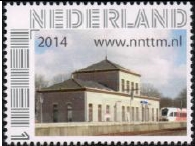 |
|
On the occasion of the 150th anniversary of The Hague Tram Company, HTM, these stamps were issued (from top to bottom): horse tram + steam tram motor car 819 + motor car 265 motor car A327 + trailer 505 motor car 164 + motor car 810 motor car 90 + motor car 57 motor car 215 + trailer 14 P.C.C. 1145 + P.C.C. 1180 GTL8 + GTL8 with collision nose randstadrail tram
No entry in official catalogue. |
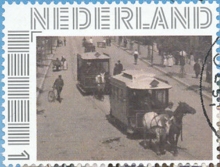
 
 
 
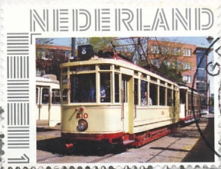 
 
 
 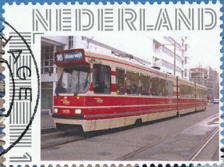
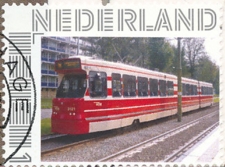 
|
|
2015 |
|
Blue Angel at Zuidbroek Station.
No entry in official catalogue. |
 |
|
Four stamps to commemorate the last rides of MAT 64 trains in The Netherlands.
No entry in official catalogue. |
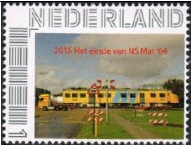
 
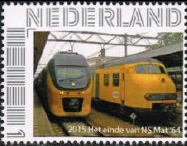
|
|
A few trains serving on international routes.
No entry in official catalogue. |

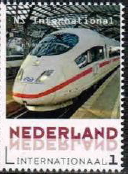 
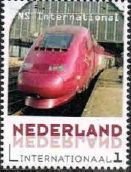 |
|
2016 |
|
Mouse as conductor.
No entry in official catalogue. |
 |
|
The "Internationalen Motivgruppe Eisenbahnwesen" IME held its 49th congress in Leiden. The stamp to commemorate the occasion shows Leiden station.
No entry in official catalogue. |
 |
|
Four stamps with FLIRT 3 trains.
No entry in official catalogue. |

 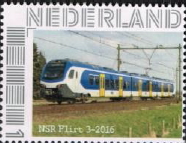
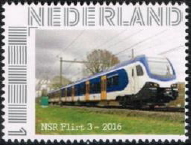 |
|
2017 |
|
VPPV is "de vereniging van persoonlijk postzegelverzamelaars" the association of personal stamp collectors.
No entry in official catalogue. |

|
|
MAT 64 plan V + MAT 64 plan 1
No entry in official catalogue. |


|
|
several NS trains, including: Head runner + Thalys a line-up of trains + a car wash for trains two Fyras
No entry in official catalogue. |

 
 
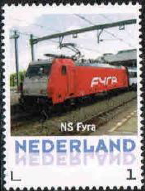
|
|
The stamp shows the cover of the 1942 time-table of the NZHTM (Noord-Zuid-Hollandsche Tramweg Maatschappij).
No entry in official catalogue. |

|
|
2018 |
|
December stamp (reduced rate) with a steam locomotive in the snow.
No entry in official catalogue. |

|
|
2019 |
|
On the occasion of stamp exhibition and fair Postex 2019 in Apeldoorn.
No entry in official catalogue. |

|
|
It is not clear who issued these personalized stamps. The following locos are shown: EETC 1254 NVBS + loco owned by H.E. Oving's Iron and Steel Company the "camel" + NedTrain 704 Nedtrain Monica + NS 1010 and 1122 NS 2412 + NS 2530 NS 2801 + NS DE3 and "camel" NS Hippel No. 508 + NS MAT '46 nr. 904 NS PEC mail carriage + NS 1312 The Dutch postal service issued an information leaflet on the PEC in Dutch. It is here (opens in a new tab or window). RailExperts 1251 + Railion R9903 railpro 603 + RailPromo ex NS 1215 Amsterdam RFF 5 Hippel from Rotterdam Rail Feeding + Veolia MaK G1206 Loco nr. 1509 NS E 189 114 Traxx at Tilburg CS station + NS 180
No entry in official catalogue. |
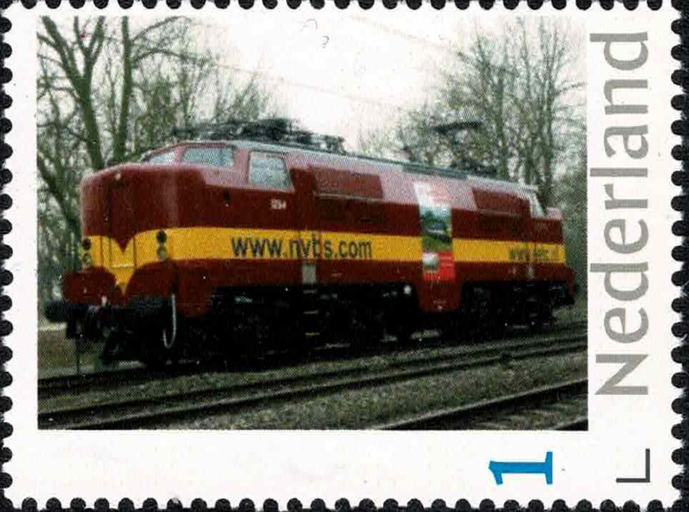
 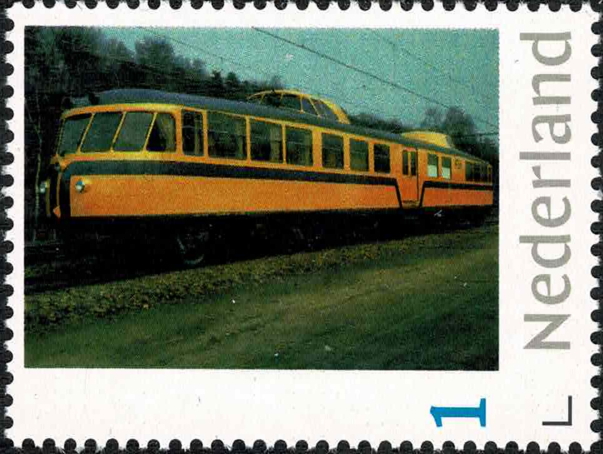
 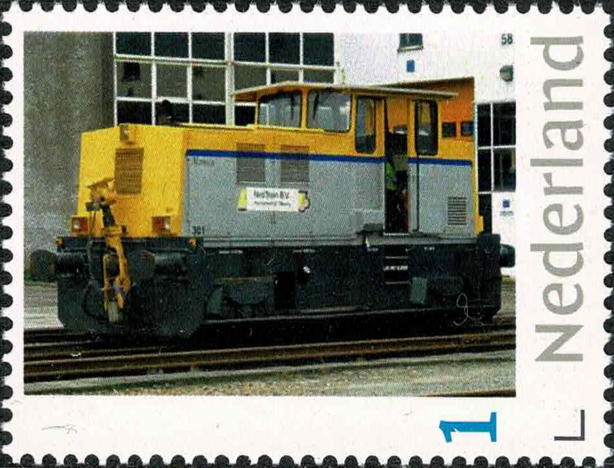
 
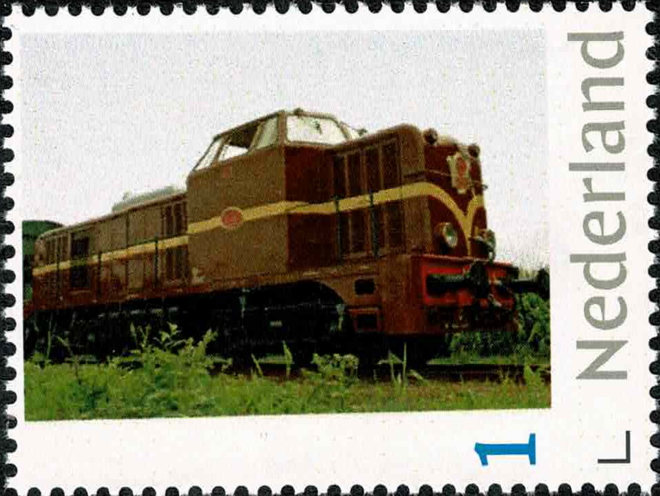 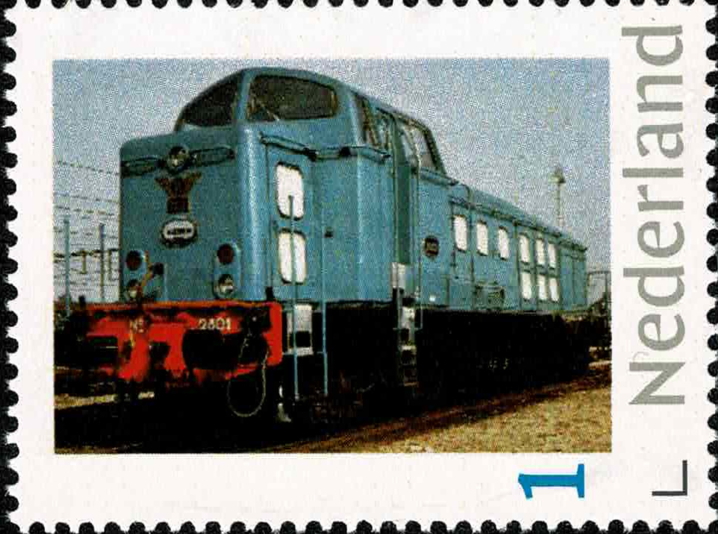
 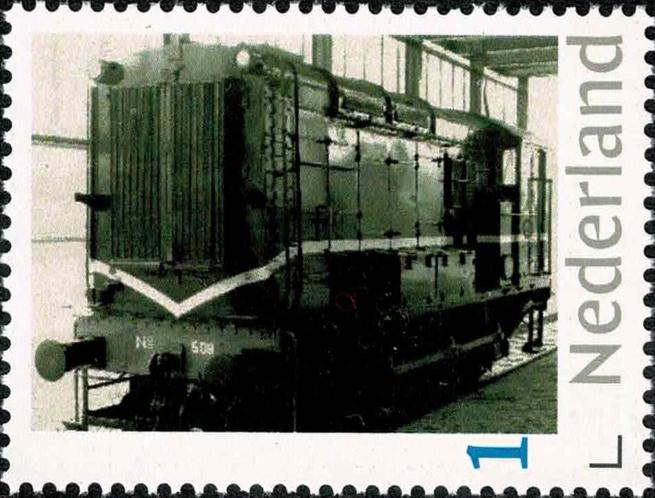
 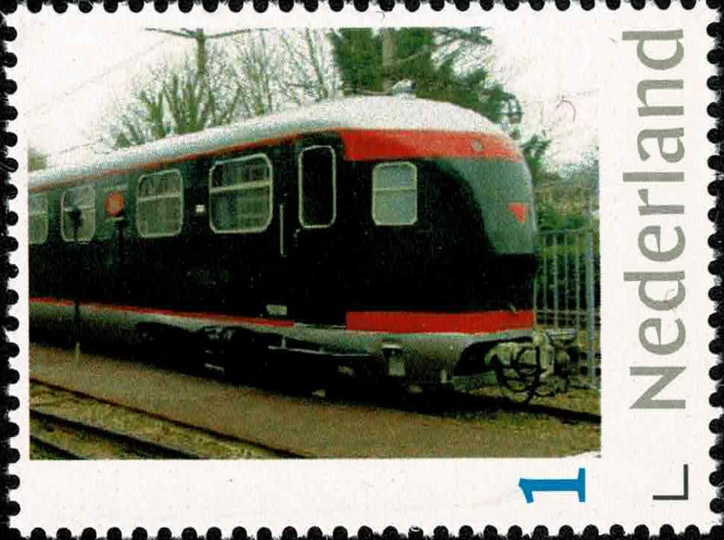
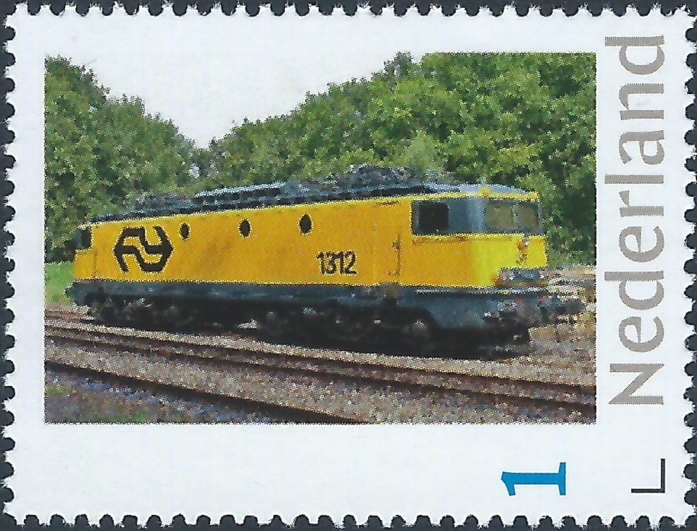 
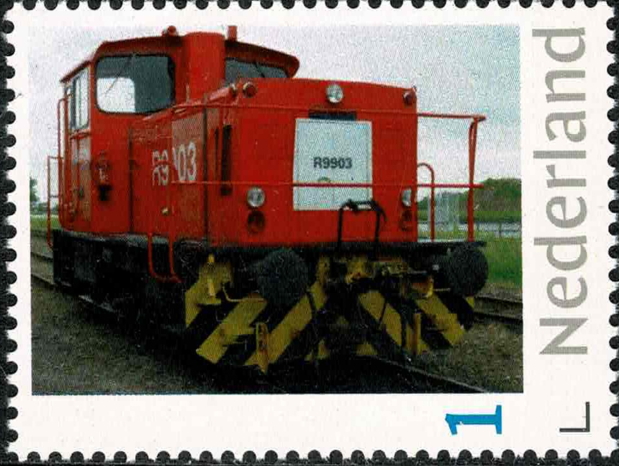 
 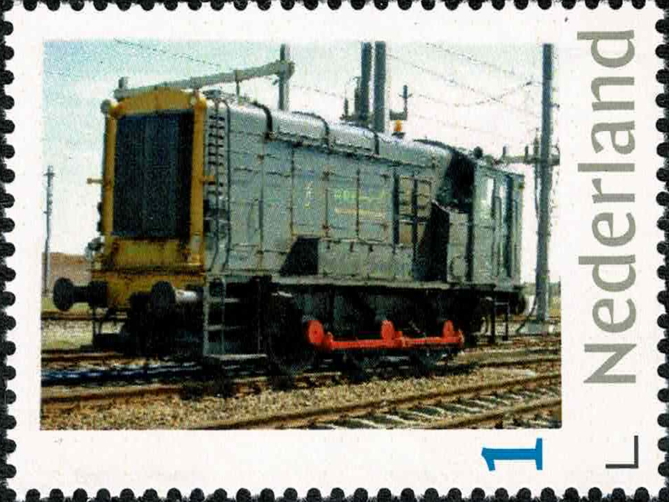
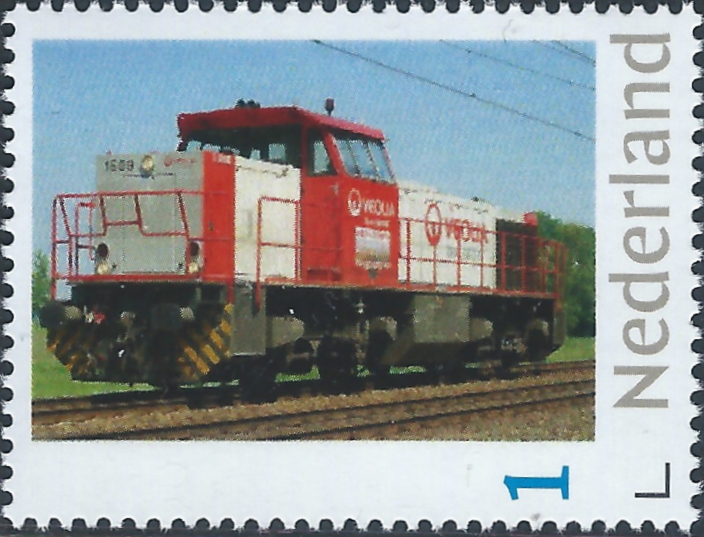 
 |
|
Mat ´64 in blue livery Mat ´46 Intercity test drive.
No entry in official catalogue. |

 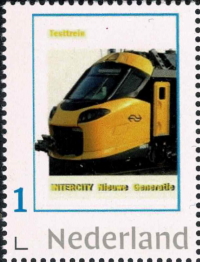
|
|
Regiorunner and Plan T.
No entry in official catalogue. |

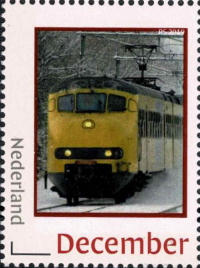
|
|
2020 |
|
The association of friends of the railway museum in Utrecht issued the following stamps in 2020: e-loco series 1500: This e-locomotive is of British origin and was taken over by NS from British Rail to reinforce the domestic service. In Britain this locomotive was known as BR 27003 "Diana", put into service in 1954. In the Netherlands these 6 locomotives (1501 to 1506) were put into service in 1970. They practically had a monopoly on the line The Hague CS - Venlo in passenger transport and were taken out of service in 1986. The 1502 and 1505 then went back to England to be included in museum collections there. This issue is dedicated to the 50th anniversary of the association of friends of the national railway museum: it was founded in the same year in which the 1500 series entered service at NS. Due to the fact that the 1501 entered service with NS fifty years ago in 2020, the locomotive temporarily found a place in the national Railway Museum. On July 1, the locomotive was delivered by the Fairtrains 1304. The image on the stamp: the 1501 was a guest in the workshop in Tilburg on November 25, 2006. That day the locomotive brought two 1100's of the SGB in Goes to Tilburg on the occasion of the presentation of the book about the series 1100. The photograph was taken by Harry Peters. SGMm 2133: In the autumn of 2020, the 2-car train set City Regional Equipment (Stads Gewestelijk Materieel) 2133, launched at the time as the new Sprinter, plan Y, was added to the collection of the national Railway Museum. Before the modification to this equipment, this set entered service as SGM 2023. The image on the stamp shows SGMm 2133 “in the wild”, on August 13, 2018 and therefore still in circulation, in Wijchen. The photographer is Leon Schrijvers. [source: newsletter VVNSM]
No entry in official catalogue. |
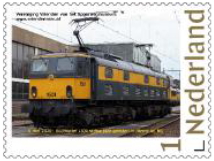  |
|
Eurostar trains travel from Amsterdam to London through the Channel tunnel.
No entry in official catalogue. |
 |
|
Seven trams from the Public Transport Museum in The Hague. The stamps were made by C.F.Riem, whose site is: personalstampsite.nl. The trams are (from left to right, top to bottom): tram 819 built in 1927 tram 265 built in 1920 tram 1022 built in 1952 tram 164 built in 1908 tram 1304 built in 1971 tram 810 built in 1927 tram 37 (?? should be 57 I think) built in 1923
No entry in official catalogue. |

 
 
  |
|
The first shows Fyra V250. The Second shows SGmm.
No entry in official catalogue. |
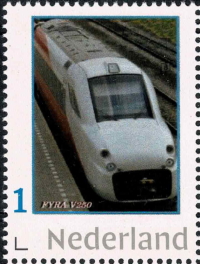

|
|
Thalys in Belgium
No entry in official catalogue. |
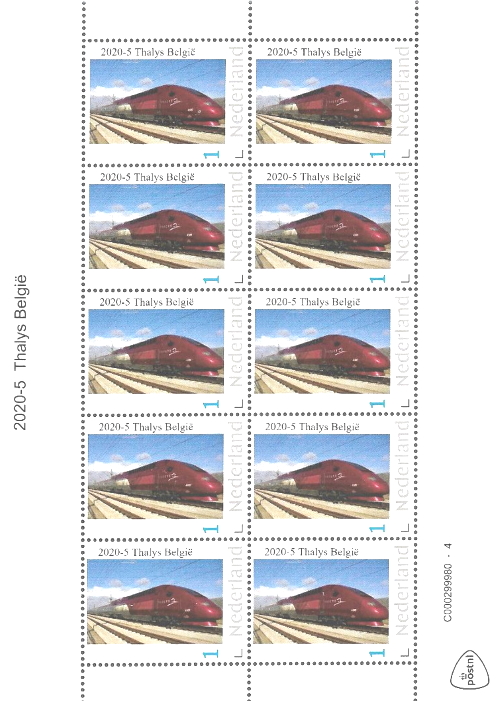  |
|
2021 |
|
The Camel NS Sprinter SNG VIRM MAT ´64 bloody nose
No entry in official catalogue. |
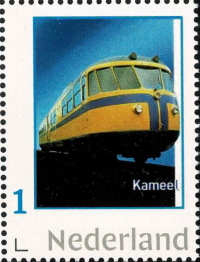
 

|
|
Rail Force One 1829 NS 703 NS 2317 NS 2425 Traxx DC CapTrain V100
No entry in official catalogue. |

 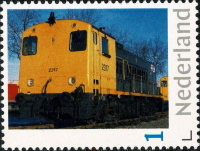
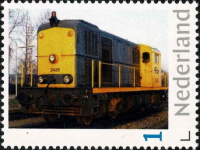 
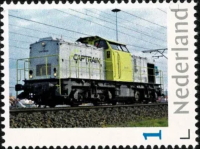
|
|
Several Dutch railway posters.
No entry in official catalogue. |
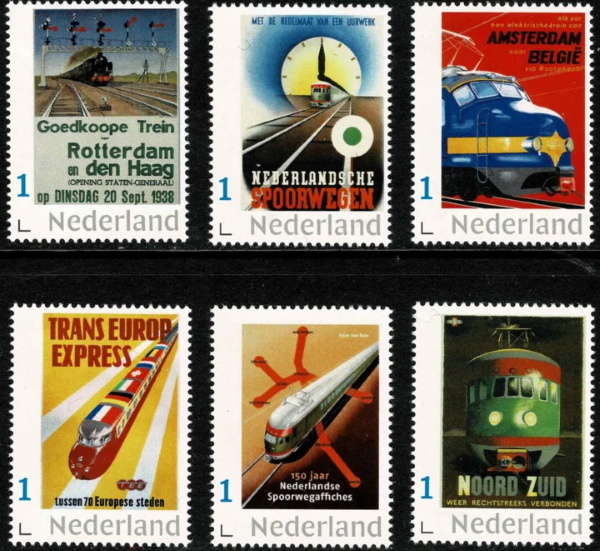

|
|
Thalys Special train with comic figures Tintin, captain Haddock and Bobby, which runs from Antwerp to Paris v.v.
No entry in official catalogue. |
   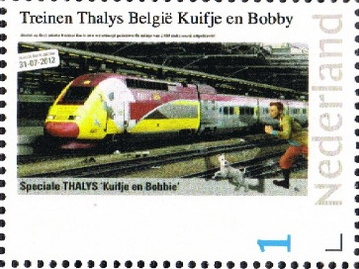 |
|
2022 |
|
A red workhorse, a tram with the NS logo and a tram in The Hague passing through the so-called fishnet stocking (Netkous).
No entry in official catalogue. |

  |
|
These stamps show Dutch steam locomotive numbers 1643, 3815, 3920, 4718 and 5554 on five different stamps. This publication is based on reproductions of original photos from the NS archive. NS 1643: The NS 1600 series was a series of express train steam locomotives of the Dutch Railways (NS) and its predecessors Maatschappij tot Exploitatie van Staatsspoorwegen (SS), Hollandsche IJzeren Spoorweg-Maatschappij (HSM) and Nederlandsche Rhijnspoorweg-Maatschappij (NRS). The locomotives taken over from the NRS and SS - NRS 101-109 (HSM 350-358, NS 1601-1609) - pleased the HSM so much that 40 units were reordered from Sharp Stewart and Company. These entered service between 1891 and 1892 with numbers 359-398. In 1900 another order of five followed with Sharp Stewart and Company with numbers 399-403. Finally, in 1903, the series 404-408 built by the North British Locomotive Company, into which Sharp Stewart and Company had meanwhile been absorbed, entered service. In 1921 the locomotives were renumbered in the NS series 1610-1659. The 1614, 1633, 1636, 1637 and 1646 were fitted with a superheater in 1921. It was the intention to provide the entire series with this, but due to disappointing results, it remained with these five locomotives. In the years 1936-1949 they were taken out of service. The 1614, which was removed in 1938 and used in Zwolle as a stationary boiler for steam heating, was put back into service in 1940, where the superheater elements were "short-circuited". Locomotive 1622 was the last to be removed from this series in 1949. NS 3815: The series NS 3700 consisted of 120 express train steam locomotives with the axle arrangement 2'C of the Dutch Railways (NS) and its predecessor, the Maatschappij tot Exploitatie van Staatsspoorwegen (SS). When the rolling stock of the HSM and the SS merged in 1921, the locomotives of this series were given the NS numbers 1701-1835. The NS continued the conversion with superheater on 92 locomotives, based on the last converted six, between 1921 and 1930. After the first locomotives were converted by the Tilburg workshop, the help of Werkspoor in Amsterdam and Utrecht was now also called in. Due to the financial crisis, as a result of which NS also had to review its spending pattern, the serial conversion of 1700s with a superheater came to an end after one hundred locomotives. Nevertheless, between 1936 and 1939 four more locomotives, whose boiler had to be replaced, were also fitted with a superheater. Plans to implement this for all remaining locomotives that were not yet equipped with a superheater failed because the costs were considered to be too high. Meanwhile, in 1938, the removal of the first locomotives of this series not equipped with a superheater had already started. NS 3920: The series NS 3900 was a series of steam locomotives for express trains, built in 1929-1930 for the Dutch Railways. At the end of the 1920s, the Dutch Railways needed an express train locomotive that was stronger than the class 3700, because more and more wooden passenger coaches were being replaced by steel ones. Meanwhile, the axle weight could also be increased from 16 tons to 18 tons. This resulted in a design based on the example of the series 3600 and 3700, so with an axle arrangement of 2'C. The 3900 received the bar or bar frame of the 3600. In design of boiler, cylinders and cab, she resembled an enlarged 3700 with a more powerful boiler. The cylinders were given a diameter of 420 mm instead of 400 mm. This increased both the pulling force and the power by about 15 percent. The same boiler was later used in the class 6300 tender locomotives. The tender was roughly the same as that of the series 3600 and the later built 4-axle tenders of the series 3700. The series was able to quickly bring the heaviest passenger trains up to a speed of 100 km/h. The German factory Henschel & Sohn delivered the locomotives in two series in 1929 and 1930. The first 22 locomotives from 1929 (3901-3922) were initially not equipped with smoke deflectors. To prevent the wind from blowing the smoke from the chimney in sight of the driver, these were installed in 1930. In the second series of ten (3923-3932) this happened immediately upon delivery. NS 4718: The series NS 4700 consisted of 35 steam locomotives for freight trains, which were in service with the Dutch Railways from 1944 to 1958. As early as World War II, the Dutch government ordered 50 steam locomotives in London from the Swedish factory Nydqvist & Holm AB (NOHAB) in Trollhättan in order to quickly bring the fleet of locomotives, which was severely depleted by war, up to standard. To save time, existing models of typical Swedish locomotives were chosen. This concerned 15 express train locomotives with axle layout 2'C (series NS 4000) and 35 freight locomotives with axle layout D (NS 4700). The 4700s were delivered in the years 1944 to 1946 after the example of existing locomotives of the Swedish private railway company Grängesberg-Oxelösund (TGOJ) and were very modern by Dutch standards. They were derived from the Swedish type M3b. Some tenders and boilers were supplied by Motala Verkstad and ASJ. The first locomotive delivered was mistakenly given the wrong number. When the locomotives were ordered, the name Swedish Freight Locomotive was given. The manufacturer saw this as a type designation and therefore called the first locomotive 'ZG1'. As with the series 4000, they had a 3-cylinder gear and all axles ran in SKF ball bearings. On delivery they were fitted with a large cow catcher and a large spotlight, which were immediately removed. The driver's cab was completely closed off with a bellows on the tender, which was identical to those of the series 4000. In contrast to locomotives designed in the Netherlands, the instruments, such as the pressure gauge and the speedometer, were clearly arranged in front of the regulator key (driving handle). Like the series 4000, the series 4700 was also equipped with steel inner fireboxes. In all 4700s these were replaced by a copper one. The locomotives had electric lighting, including the driving gear, to facilitate nighttime maintenance. They were nicknamed Christmas tree by the staff because of this. In 1949 a new numbering scheme was introduced for the tenders of the steam locomotives. From that time on these were given their own numbers; for the series 4700 the numbers became 4016-4050, making the tenders of the series 4000 and 4700 more easily interchangeable. NS 5554: The 5554 was delivered in 1905 by the Dutch company Werkspoor. The series NS 5500 was a series of tender locomotives of the Dutch Railways (NS) and its predecessor Hollandsche IJzeren Spoorweg-Maatschappij (HSM). After the good experiences with the passenger train locomotives 350-398 and freight train locomotives 601-616 delivered by the Sharp Stewart and Company factory, the HSM decided to also order a series of tender locomotives from the same factory. The 309-310 taken over from the NRS performed well, but were too light for the heavier trains. The larger and stronger series 701-724 were then ordered, which were delivered between 1898 and 1900. Various parts corresponded to the other series mentioned. This series also performed well, so that a follow-up order was placed with Werkspoor, following the backordered freight train locomotives 617-647. This concerned the series 725-755, which was delivered between 1903 and 1905. As with the freight train locomotives of which the follow-up series 671-685 with superheater was ordered, a follow-up order with superheater was also ordered for these tender locomotives, which were delivered in 1907 and 1913 as the series 771-776. When the rolling stock of the HSM and the SS merged in 1921, the locomotives of this series were given the NS numbers 5501-5555. To double the coal stock, the coal box behind the driver's cab was raised in 1932, making the locomotives suitable for longer services. Because the water supply was not increased, a water car was hung behind the locomotive during the war years, which was connected to the locomotive with a hose. The 5540 was heavily damaged during the German invasion in May 1940 and was subsequently removed. The remaining 54 remained in service until the 1944 railway strike. During the strike, a large number were deported to Germany or severely damaged. After the war, only ten drivable examples remained in the Netherlands. The last examples were taken out of service in 1954. No copy has survived. source: Wikipedia
NVPH:---. |
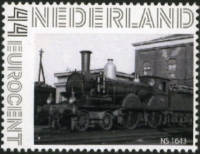
 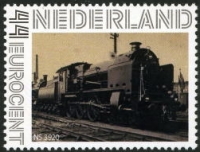
 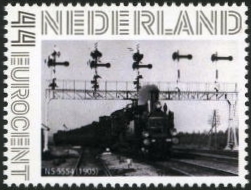 |
|
See text above. source: Wikipedia
NVPH:---. |
 
|
|
See text above. source: Wikipedia
NVPH:---. |
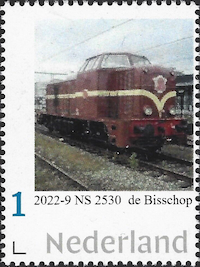
|
|
NS 1303 steam loco: Steam locomotive no. 1303 from the series 1301-1304 of the S.S. (Maatschappij tot Exploitatie van Staatsspoorwegen) later NS 4503 (1920). Ordered as NBDS 120, but delivered as SS 1303. Sold for scrap in 1947 to the Gooise Metaalhandel Hamel in Hilversum. NS CTO measurement vehicle: The Historical Diesel Equipment Foundation is a Dutch foundation that is committed to the preservation of Dutch historic diesel equipment in the field of rail transport. In 2014, the CTO measurement vehicle (ex-NS P 7918) was taken over from Eurailscout. In its original version, it is used as a CTO measuring vehicle for research by TU Delft. NS ICNG: The Intercity New Generation (abbreviated ICNG, nicknamed Wesp) is a type of new single-deck train set of the Dutch Railways (NS). The trains are of the Coradia Stream type, are designed and built by Alstom, and are intended for the NS intercity network. The trains are intended to replace older rolling stock such as the oldest ICMms and the ICRm. In addition, the rolling stock is intended to accommodate the growth in the number of passengers. The trainsets will be used on the main rail network, the largest part of the NS rail network. The HSL South is part of this, where they indirectly became the replacement for the failed Italian V250. NS ICNG and Head Runner: See above for ICNG. Intercity material (ICM for short) is a train set of NS Reizigers that is mainly used in intercity train services. Due to the nature of the deployment - especially the Rotterdam/The Hague-Groningen/Leeuwarden intercity trains, sometimes preceded by services on the night network, it is the train type that covers the most kilometers per day: usually more than 1,000 km per day with peaks of more than 1,800. The rolling stock name is Plan Z. The train, designed by the design agency of designer Raymond Loewy, was nicknamed Koploper, because of the so-called walk-through head. This walk-through head was removed after the modernization of the trainsets. The refurbished trains are also referred to as Intercity Materie Modern (ICMm for short). The first trainsets entered service in 1977. The trains built between 1983 and 1994 still run daily on the Dutch railway network. The ICMms, together with the VIRM, form the most important rolling stock on the connections between the Randstad and the rest of the country. Strukton 303007 Vossloh MAK G1206: The MaK G 1206 is a German diesel-hydraulic locomotive, built by Maschinenbau Kiel (MaK) and its buyer Vossloh. For the time being, 246 units have been built since 1997. In the Netherlands, the G 1206 is/was used by ACTS, Lineas, Locon, ERS Railways, Captrain, Rurtalbahn, Independent Rail Partner, LTE, Rail Force One and Strukton, among others. Strukton VST07-3: The NS locomotive series 2200 is a series of diesel-electric locomotives that were used by the Dutch Railways between 1955 and 2003. Some locomotives went to rail contractor Strukton: the 2270, 2282 and 2328, which were given 30 in front of the number and were painted entirely yellow. These locomotives have since been overhauled, with only the undercarriage and part of the cabin remaining. In 2007, Strukton leased these three locomotives to Eurailscout Inspection & Analysis, which converted the locomotives into a video inspection train. In addition to the old Strukton numbers, the locomotives were given the new numbers VST07-1, VST07-2 and VST07-3. These have now been taken out of service at Eurailscout. NS-PEC mail train: In the thirties, forties and fifties streamlined postal carriages, type Pec, were built for mail transport in Dutch trainsets. These mail coaches were intended to be coupled with trainsets, and were therefore equipped with automatic couplings. They were owned by the state company PTT, but rode on the trains of the Dutch Railways, which also took care of maintenance. These mail coaches could be coupled with the streamlined stock built from the 1930s up to and including the Plan U trainsets from the 1960s. The mail coaches were delivered in a dark green color scheme with red piping, similar to the streamlined stock. In the 1960s, the color scheme was changed to grass green with sand yellow trim, in which the electric streamlining equipment had also appeared. The postal coaches were taken out of service between 1966 and 1979. One copy has been preserved in the collection of the Railway Museum. NS Plan U 141: Plan U was a type of three-piece diesel-electric train set (official designation: DE3) of the Dutch Railways. These trainsets were built between 1960 and 1963 by Werkspoor in Utrecht and entered service under numbers 111-152. Compared to the previous electrical equipment '54 (Hondekop), the nose had a more modern design. Originally the plan was to give the sets the same nose as the DE4 TEE trainsets also built by Werkspoor. Due to the angular nose shape of the TEE trains, however, the rain kept hitting the windows during heavy rainfall, which caused a lot of inconvenience to the driver. That is why the new diesel trainsets were given a rounder nose, which was later also applied to the electric Mat '64. NS Sprinter SNG: The Sprinter New Generation (abbreviated SNG) is an electrically powered train set of the Dutch Railways (NS). It was designed and built by Spanish train builder Construcciones y Auxiliar de Ferrocarriles (CAF), using the Civity platform. The type is mainly intended to replace older train equipment, primarily the Stadsgewestelijk Materieel, which will be decommissioned in 2021. The purchase is also intended to accommodate the expected growth in the number of passengers on the main rail network. Just like the Sprinter Lighttrain (SLT), the Sprinter New Generation has an interior with lots of light and space. This is achieved through the use of Jacobs bogies, which enabled wide box transitions. The low floor makes the train more accessible for disabled people. The SNG can be distinguished from the SLT on the side, among other things, by the oblique white stripes at the ends. NS control car: A control car is a carriage that is provided with a control car at one end. From this steering position, the driver can operate the locomotive remotely. In order to transmit the electrical signals required for this, all carriages between the locomotive and control car must be fitted with control cables. The carriage on the side of the steering position is equipped with the prescribed front signals, in addition to the marker lights present on all carriages, and a horn. There is also pull-and-punch work available. On the Benelux rolling stock, these are the normal buffers and screw coupling, and on the double-deck rolling stock, a BSI coupling. The advantage of a control car is that the locomotive does not have to be shunted to the other side of the train at the terminus. Only the driver walks to the other side of the train. A train composed of a locomotive, a control car and (usually) ordinary carriages is called a push-pull train.
No entry in official catalogue. |

 
 
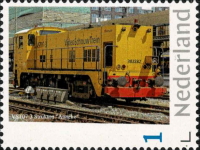 
 

|
|
2023 |
|
Philamaxx Christmas stamp with Märklin loco.
No entry in official catalogue. |
 |
|
Philamaxx issued two stamps with the NS New Generation ICNG and new sprinter Blue Head (Blauwkop)
No entry in official catalogue. |

 |
|
ACTS-1251: ACTS Nederland BV was a Dutch railway company. The abbreviation originally comes from Afzet Container Transport Systeem (Sales Container Transport System). On February 5, 2011, the activities were continued by Husa. In 1999, thirteen locomotives were purchased in Belgium, Germany and the Netherlands. The Dutch locomotives were of the ex-NS series 1200. These locomotives were saved from demolition by two railway interested parties. NS wanted to scrap all type 1200 locomotives immediately, but by means of the Competition Act it was possible to retain a number of 1200s for ACTS. After the 1200s were taken out of service at ACTS, a few locomotives were privately owned in 2010 and leased to Euro-Express Traincharter (EETC) for car sleeper trains. On February 19, 2011, the 1254 was presented in the new color combination of EETC, red-brown with yellow band. Until the end of 2011, this locomotive was also stickered with the logo of the Dutch Association of Interested in Railways and Tramways (NVBS), which had been in existence for eighty years in that year. In April 2015 it was announced that the car sleeper train will no longer run due to sharply increased costs. Some of the locomotives in the list below have already been given a new destination. On September 26, 2015, the 1251 and 1254 were transferred from the Watergraafsmeer to Blerick for storage. The 1254 was deployed from November 2015 (still in EETC livery) at HSL Logistik. However, due to a faulty traction motor, the 1254 was parked in 's-Hertogenbosch at the beginning of 2016, pending what will happen next. From November 1 to December 31, 2016, the 1254 was leased by Captrain. The 1202 is preserved in the collection of the Dutch Railway Museum and is painted in the Berlin blue version. In 2022, this machine will be overhauled in the depot of the museum in Blerick.
No entry in official catalogue. |
 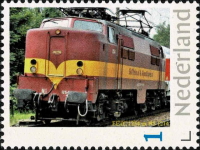

|